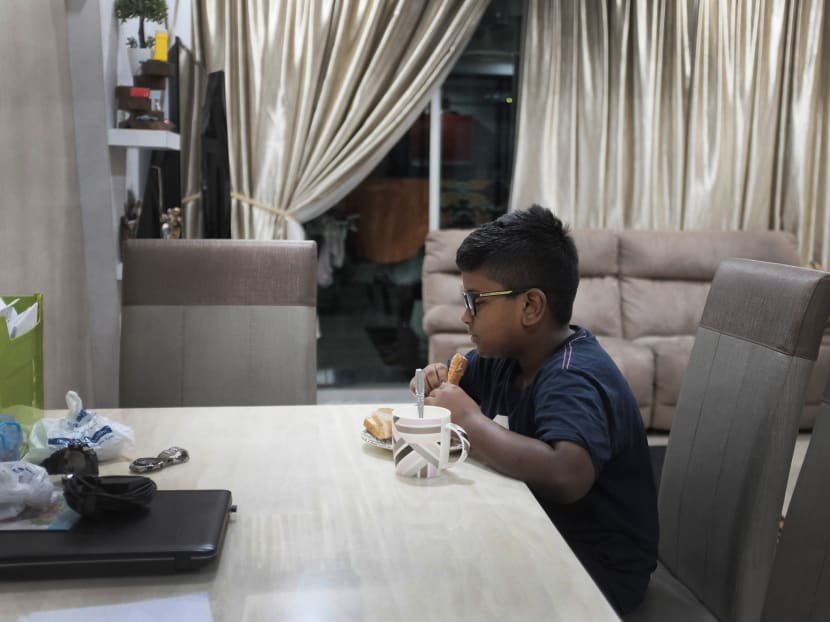Rising school fees for non-S’poreans force rethink among Johoreans
SINGAPORE/JOHOR BARU — Eight years ago, it was a no brainer for the parents of 15-year-old Danson (not his real name) to send him to a primary school in Singapore. They wanted him to be taught in English, and an international school in Johor would cost at least twice as much.

A student, eating his breakfast, before making the long journey across the Causeway to Singapore to attend school on Oct 25, 2017. Photo: Jason Quah/TODAY
SINGAPORE/JOHOR BARU — Eight years ago, it was a no brainer for the parents of 15-year-old Danson (not his real name) to send him to a primary school in Singapore. They wanted him to be taught in English, and an international school in Johor would cost at least twice as much.
But the fee hikes for permanent residents and foreigners began in 2011, when Danson was in Primary Three. From S$15 a month, Danson's fees increased to S$22, then S$40 and S$90. Now in Secondary Three at Northland Secondary School, his Malaysian parents are forking out S$200 each month and the amount will hit S$400 and S$460 when he enters pre-university.
"It's a bit hard to keep up," said his mother, a 37-year-old dental nurse who only wanted to be known as Mdm Tan.
With the cost of Singapore's schools continuing to rise for foreigners, it is likely Danson's younger brother Jason (not his real name), 1 – who, unlike him, is not a Singapore permanent resident – will be the product of a different education system.
Mdm Tan and her husband will likely enroll Jason in an international school near their home in Permas Jaya, Johor Baru. Fees range from 1,550 Malaysian ringgit (S$498) to RM1,750 a month at schools such as Austin Heights, Seri Omega and Tenby – comparable to what they would pay in Singapore.
For families in Johor that have, for decades, packed their children off on schoolbuses in the predawn hours to study across the Causeway, the Singapore Ministry of Education's (MOE) announcement last month of yearly fee hikes for non-citizens until 2020 will be a moment of reckoning.
From 2018 to 2020, school fees each year will increase by S$25 to S$60 per month for permanent resident students, and by S$25 to S$150 per month for international students.
WILL LATEST HIKES BE THE TIPPING POINT?
For some, the hikes will mean starkly different choices after doing their sums. The weakening of the ringgit against the Singapore dollar in recent years has not helped, said Malaysians living in Johor.
The Singapore government began sharpening the distinction between citizens and non-citizens in education, healthcare and other major policy areas in 2009, but the latest increases mean the cost of schools in Singapore may now be on par with that of international schools in Johor.
Signs of a shift may have surfaced. Last month, Malaysian daily The Star reported school van providers plying between Johor and Singapore had seen a drop of up to 15 per cent in the number of student passengers in recent years. Operators Superman and Doraemon reportedly used to ferry a total of about 500 students.
There are also Malaysian students cross the Causeway on public buses such as SMRT's service 950 and SBS Transit' services 160 and 170.
Housewife Zaira Nazeem told TODAY she had placed her oldest daughter in an international preschool in Johor, expecting to enroll her in a primary school in Singapore this year. But when the time came, the family could not afford the monthly fee of S$390 for nationals from countries in the Association of Southeast Asian Nations.
Mdm Zaira and her contractor husband have three other children aged 1 to 6, and her oldest daughter is now attending the Infant Jesus Convent, a Malay-medium national school in Johor where school fees and textbooks are fully subsidised by the Malaysian government.
The switch in language of instruction was difficult for the girl, said Mdm Zaira. "She started in an international Montessori school, so it is hard for her (to have subjects taught) in Malay. She can understand but she doesn't want to speak (Malay)," she said.
Another parent, policewoman Rafidah Abdul Razak, 35, said she is now less keen to have her daughter, 3, schooled in Singapore because of the increasing fees.
.embed-container { position: relative; padding-bottom: 56.25%; height: 0; overflow: hidden; max-width: 100%; } .embed-container iframe, .embed-container object, .embed-container embed { position: absolute; top: 0; left: 0; width: 100%; height: 100%; }FOR SOME, A SINGAPORE EDUCATION IS WORTH THE PRICE
Other families with children already studying here said they would tighten their belts to cope with the steeper fees.
Technician Francis Alan, 37, whose son Henry is in Primary Two at Greenwood Primary School, said the effort was worth it. "Education in Singapore is one of the best in the world. We want Henry to become very marketable when he becomes an adult," said Mr Francis, who works at Amgen Singapore Manufacturing in Tuas.
Henry wakes up at 3.30am on weekdays to catch the 4.30am bus to make it to school by 7.30am. Despite this, he was twice late for school – when Singapore introduced a reciprocal road charge for foreign vehicles, and when new automated gantries for motorcyclists at the Malaysian customs malfunctioned and traffic spilled over to the bus lanes.
"I don't think I get enough sleep," said the boy, a Singapore permanent resident.
The family, who lived in Kulai, had already tried shaving 30 minutes off Henry's commute by renting an apartment 10 minutes away from customs a month before he began Primary One.
To buy the boy more sleep and time for rest, the family recently purchased a four-room flat in Sembawang for S$320,000 and will move into it in February.
To manage the cost of living, Mr Francis applied for citizenship last September. "I am worried about the school fees," he said, adding that Henry's school expenses and pocket money add up to S$500 a month. Even if fees continue to rise, "we still need to send him (to a) Singapore school. There is no other choice", he said.
As for Danson's and Jason's family, who currently live with Mdm Tan's sister in Yishun, the plan is to relocate to Johor when Jason begins primary school, while Danson continues his education in Singapore.
Mdm Tan and her husband, a Work Permit holder who is a waiter at a nightclub, hope to set up a small restaurant north of the Causeway to fund the family's dreams on both sides of it.
"How good (it would) be if every child can benefit from a better education without being divided by nationality, race, or religion," she said.








